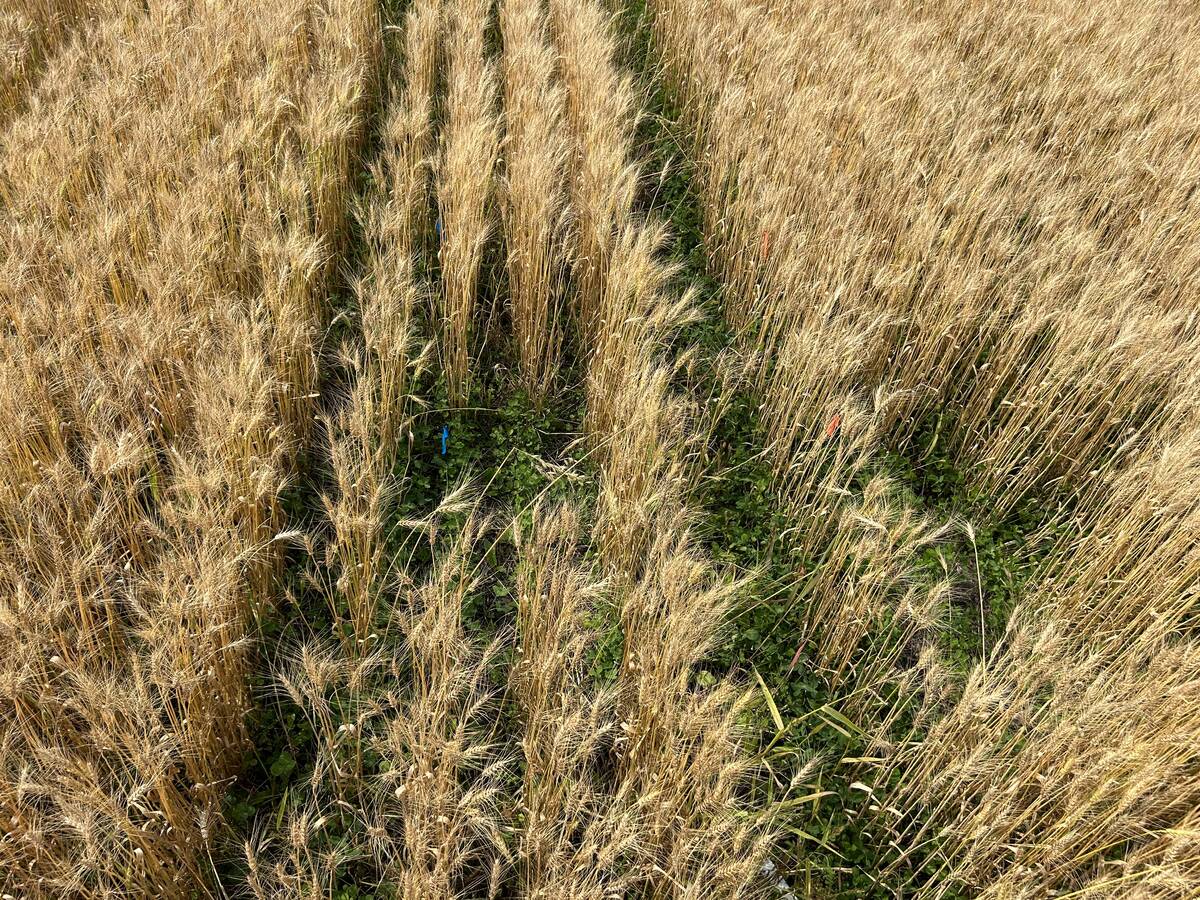Canola prices dipped after hitting record highs last spring, but could western Canadian producers see a price rally in the weeks ahead? MarketsFarm analyst Bruce Burnett says there’s a good chance prices will recover.
In an interview with Grainews in August, Burnett said virtually all commodities — including canola — experienced “a big, macro trade sell-off,” and corresponding price drops over the summer.
[VIDEO] Are canola prices poised to recover?
Read Also

Cover crops seeded with wheat show no yield penalty in Manitoba trials
Research at Manitoba Diversification Centres shows farmers can seed legumes with spring wheat to establish cover crops without hurting yield, even in dry years.
This downward turn, he said, was “somewhat artificial” since it was largely fuelled by investors, especially on the speculative side of the market, who were selling off commodity investments due to concerns about a recession restricting demand.
“The (canola) market has turned somewhat bearish,” said Burnett. “We are still in that environment, but from a global basis the oilseed situation really hasn’t changed too dramatically year on year. My thought here is when we get over some of these macro fears, we’re probably going to start to see a rally.”
In mid-August, canola was trading in the neighbourhood of $830 per tonne. As Burnett pointed out, that’s a few hundred off the price peak of $1,081.25 per tonne on April 22 but it’s still considerably more than prices in the $500-per-tonne range in August 2021.
“These are still very, very good canola prices,” Burnett said. “If you’re talking to me in most years, outside of last year, I would have been labelled crazy to say, ‘Well, prices probably could go up from here.’”
Burnett said there’s room for canola prices to recover from the summer price dip because the supplies of vegetable oil globally are still relatively tight. “That’s going to be an overlying factor here as we go through this marketing year.”

Burnett said vegetable oil supplies have been tightening over the past decade. “The global vegetable oil use goes up somewhere between five and 10 million tonnes a year. That’s the oil, that’s not seed, so you have to produce a lot more seed to make that happen.”
Burnett maintained there are a few things savvy canola marketers will want to keep an eye on in the months ahead.
The war in Ukraine
Burnett said an end to the war between Ukraine and Russia would likely cause downward pressure on vegetable oil prices in general, since those two nations are the world’s biggest producers and exporters of sunflower oil. They also produce rapeseed but it’s a relatively minor crop in both countries.
“Certainly, there are a lot of customers for sunflower oil around the globe who are trying to find alternative oils or oilseeds to crush in order to make up for the losses they’ve had from imports from that region,” said Burnett. “If you unleash some of the sunflower crush capacity and production that these two countries have into the vegetable oil market, it would pressure prices.”
Burnett said an end to the conflict would have a short-term effect on vegetable oil prices, but this may not last long term due to the lag in getting oilseed production in Ukraine and Russia back up to pre-war levels. “Their production has been disrupted, and it takes usually a year or more to get it back into the cycle.”
However, Burnett doesn’t see the war ending any time soon. “I’m still firmly in the camp of those who believe this war is going to continue longer than we probably think.”
Transportation constraints
Burnett said despite the summer sell-off in commodity markets, it’s important to recognize that Canada is still very much in a commodity boom.
“Canada is a commodity exporter,” he said, which means canola has to compete with grains, oil, coal and all the other commodities — potash exports in particular are “extremely strong right now” — being shipped out from the West Coast and other Canadian ports.
“There is going to be a constraint on supply of transportation,” Burnett said.
“Last year, there were relatively few issues … but we had such a small (canola) crop to export, it didn’t matter as much to the local price farmers were seeing. But this year, any type of outages or, just again, the general fact we’re trying to export a lot of goods out of the West Coast this year, could have an impact,” he added.
“If you signed contracts for delivery, whatever month it is, and if things are going well, that may be fine. But if we see some delays on the transportation side, then those contracts may be pushed back in terms of when you actually have the delivery opportunity.”
Burnett said because of this, canola producers could benefit from diversifying their end-users, “especially if you do have the option of moving to a crush plant.
“If you’re delivering to the elevator, in most cases, that’s going for export. If there are export delays, then the elevator will not take the product in (even) if you’ve already sold it to them,” he said.

“Crush plants operate on a different basis,” Burnett added. “They do have their own snafus, like if they have a production outage or something like that, (but) usually they will take the grain. They’re probably a little bit more reliable from that side, so that reduces the risk of having a contract being pushed three months down the line.”
Rise of biofuels
According to United States Department of Agriculture figures, global consumption of rapeseed/canola oil annually is almost 30 million tonnes. Burnett said, of that, about eight million tonnes (or just under 27 per cent) is used for industrial purposes. “Vegetable oils have been used a long time in the industrial sector.”
Burnett noted that portion of the world’s vegetable oils earmarked for industrial use is growing, and a lot of this has to do with a burst in demand for biofuels in North America, particularly biodiesel and renewable diesel products. Both biodiesel and renewable diesel can be derived from vegetable oils (as well as other agricultural products) but they differ in the way they’re processed.
“We’re probably going to consume more of our vegetable oils this way as that sector grows,” Burnett said. “The increased demand through this increase in biofuel use is good news for the canola markets in general.”
You can already see it in Canada. Spurred by growth in the biofuel market, a cluster of canola crush plants are being constructed or expanded in Saskatchewan. The first ones could be operational by 2024.
Richardson International announced in March it was doubling its crushing capacity at its plant in Yorkton, Sask., while grain handling heavyweights Cargill and Viterra each announced in April plans to build major canola crush plants in Regina. Earlier this year, Ceres Global Ag announced a proposal to build a new canola crush plant and biodiesel refinery along the Canada-U.S. border at Northgate, Sask., but in June the company said it was suspending the plan.
Burnett said the new plants will not only provide a significant boost to crush capacity but also offer exciting new marketing possibilities for canola producers.
“Our canola crop, if you want to do just rough math, half of it gets exported and half of it gets processed domestically. When these plants come online, it’s going to be more like two-thirds to three-quarters for domestic crush and the remainder exports, depending on how many of these plants get built,” he said.
“From a practical farmer point of view, it’s going to change the dynamics of canola pricing … in terms of what the local basis and prices are,” Burnett added. “As you get more and more capacity, particularly if you live in areas where you’ve suffered from a poor basis because of, let’s say, slackness in the export market, the additional capacity will certainly make a difference in terms of your ability to market your canola.”
Crude oil pricing
One thing you might want to consider when marketing your canola is the price of crude oil. Burnett said that’s due to the intertwined relationship between the two commodities — canola is tightly tied to vegetable oil prices because of its high oil content and vegetable oil is increasingly linked to crude oil prices due to the explosion in biofuel demand.
Burnett said the linkage between canola and crude was stronger earlier this year when prices for both commodities were rising steadily, driven by supply shortages; however, it’s still something he urges farmers to keep an eye on.
“Crude oil is the largest traded commodity in the world,” said Burnett. “It’s got plenty of liquidity and so you need to pay attention to those prices because if crude oil is bearish going down or bullish going up, those are going to be influencing factors on the vegetable oil markets as well as the canola oil market.”
Burnett acknowledged there will be times when there’s a disconnect between canola oil and crude. He noted the crude oil market is one that’s very difficult to predict, “so it’s not something you want to get into on the predictive side of things, but it’s a factor that you need to consider.
“That’s a little bit of a change from just looking at it like we’ve got a big canola crop this year, so prices are going to go down, or we have a small canola crop, prices are going to go up, that type of thing,” Burnett said.
“Those factors are still going to be very important but the price of crude oil and the direction of it are also going to be playing a larger role as we go into the upcoming years here as the increased processing capacity (for canola) gets rolled out.”
Trends in cereal markets
Comparing canola with cereal markets like wheat, durum and barley, MarketsFarm analyst Bruce Burnett sees some similar trends.
For one, he says grain transportation to Canadian ports could be an issue in the months ahead. “We have to watch very closely our transportation system because we do anticipate there are going to be logistical constraints.”
Burnett also says there’s room for grain prices to go up based on continuing high demand in Europe (where the wheat crop suffered due to drought) and other factors.
“As we move into September (and) October, we think we’re probably going to see a rally in prices in general,” Burnett said. However, he cautioned better cereal supplies in the Prairies this year means farmers shouldn’t expect prices to reach the peaks they saw last year.
“It’s probably going a little bit too far to say, ‘Oh, yes, we can get back to last year’s level.’ I don’t think that’s possible,” said Burnett. “But can we move up from the current values a couple of bucks a bushel? Definitely. I think the supply and demand situation dictates that globally.”
Burnett said he does have some concerns about grain quality due to widespread seeding delays in Manitoba and eastern Saskatchewan, where some crops were as much as three weeks behind.
“Last year’s crop was an exceptionally high-quality crop, so consistently high protein, consistent grades. There wasn’t too much in terms of quality variation. This is going to be a different year from that perspective,” he said.
“That’s something to keep in the back of your mind for crops like wheat and durum that are very quality sensitive in terms of pricing. I expect the spreads between lower and higher quality to widen out in this upcoming marketing year.”
















